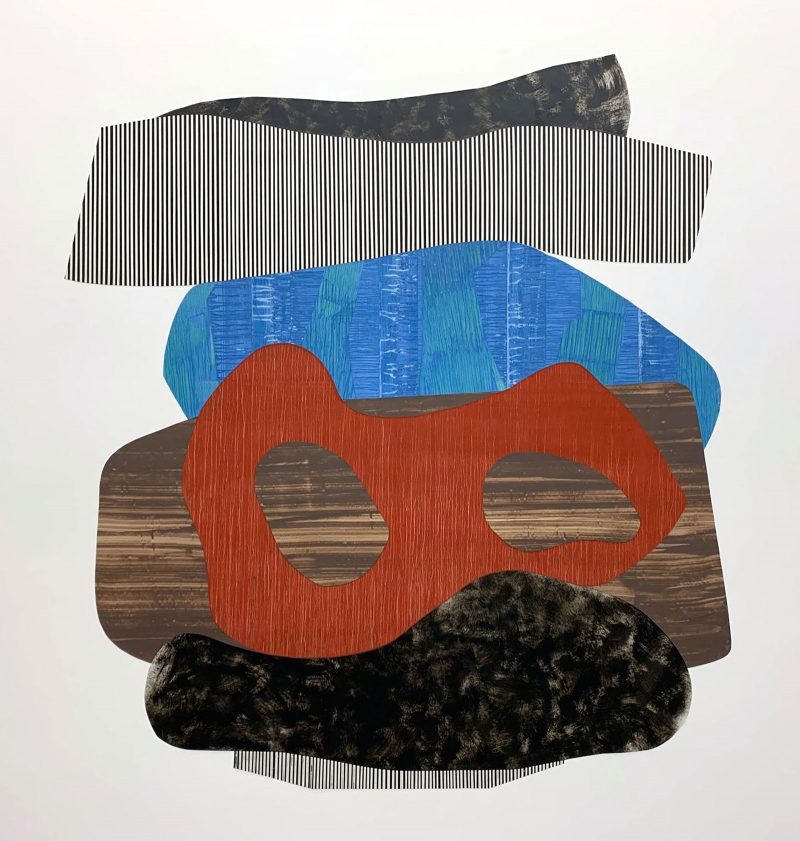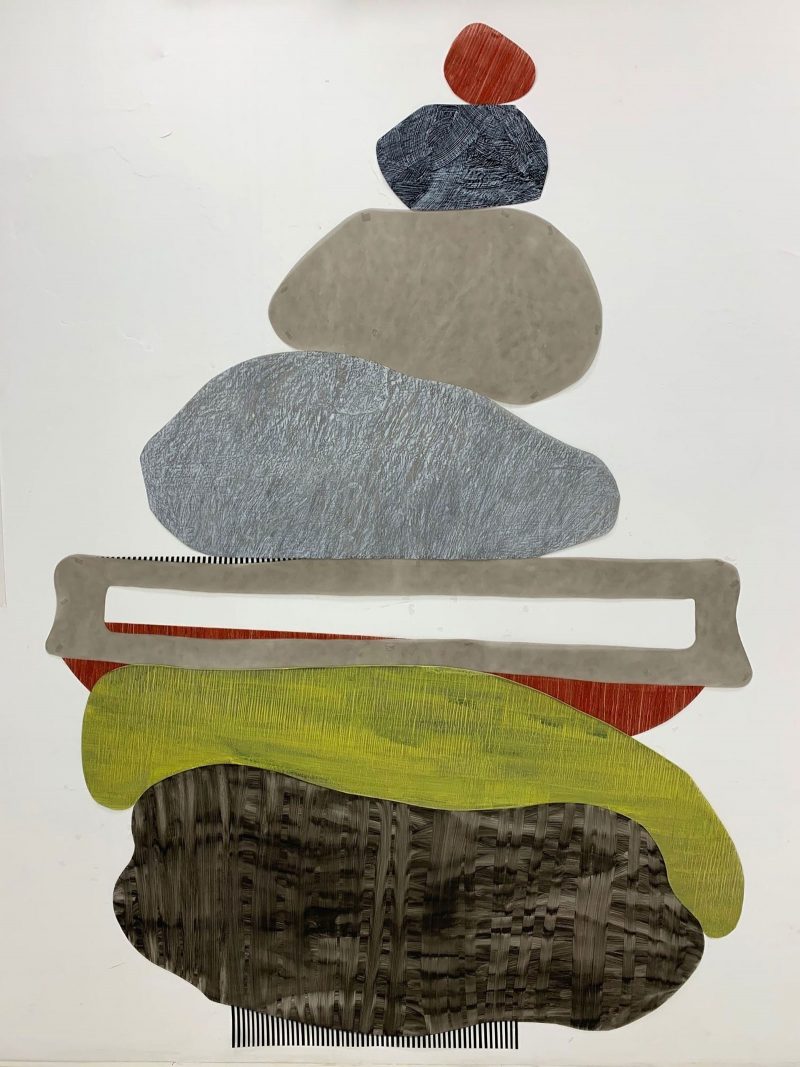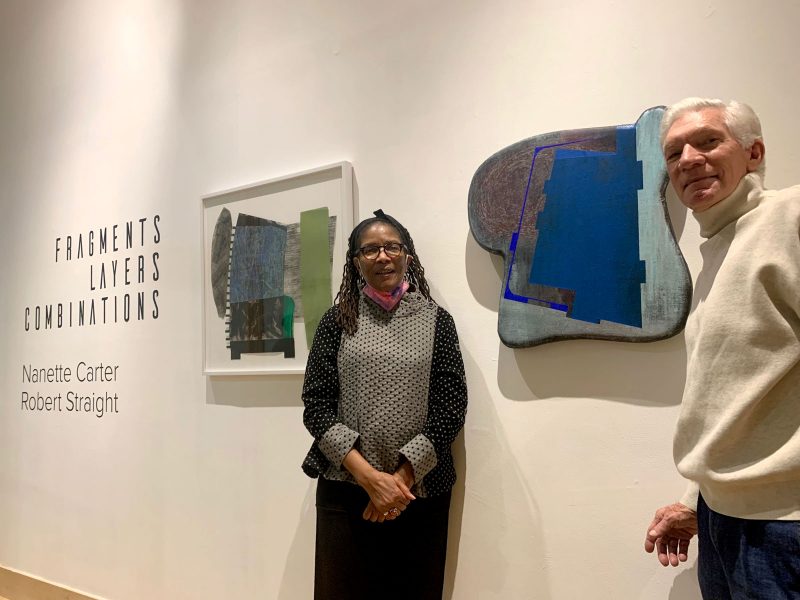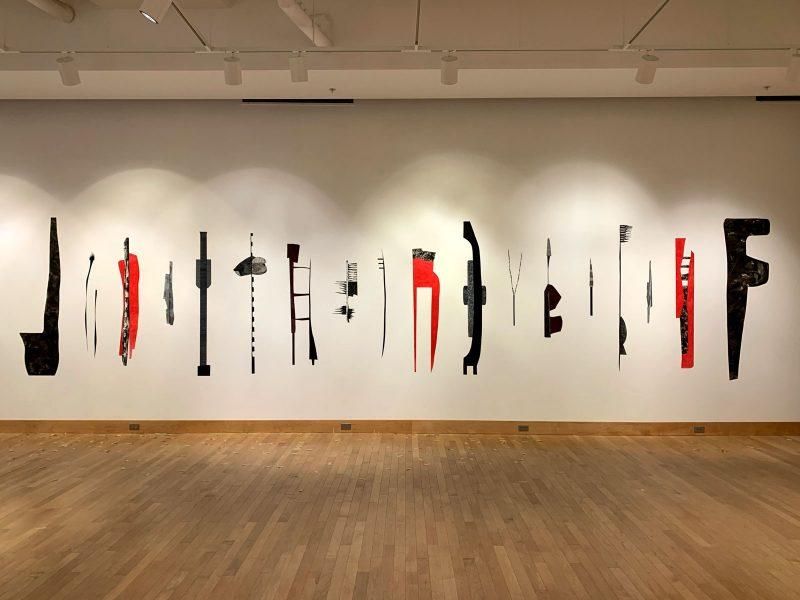Susan Isaacs interviews artist Nanette Carter, whose journey includes years as an art educator, as well as 17 years as a full-time professional artist sustaining herself through sales of her work. An amazing story. Nanette Carter is featured in a 2-person exhibit at Towson University now through April 23. Be sure to catch it if you’re in the Baltimore area..
Master artist Nanette Carter focuses on contemporary issues with an abstract vocabulary of form, line, color, and texture that explore the impact of social media, social injustice, and the balancing of life responsibilities in the 21st century through painted mylar collages. Her recent retirement from teaching has given her time to make much new work and have three exhibitions in 2022 following on a major survey of 30 years of work in 2021 at the N’Namdi Contemporary in Detroit, MI.
Susan Isaacs: You recently retired from 20 years of teaching at Pratt. Can you talk about that and about your 2021 Anonymous was a Woman award and what’s happening with exhibitions right now?
Nanette Carter: I went to Pratt for my graduate degree, and I majored in printmaking and minored in drawing. And so, a lot of that, of course, is still reflected in the work. I taught for 20 years at Pratt and enjoyed it immensely. The students are smart. They’re talented. I would always tell them “I probably learned, just as much from you, as you have from me.” They come from all over the world; it’s quite international so it made for a wonderful experience, I think, for everyone in the classroom.
I received several faculty grants during the course of that time. One of the grants, in fact, was able to send me to Cuba in 2018. I had a solo show there and we actually created a catalog with that money. I brought art materials and taught a class. The year before I left Pratt, I received what they call the Sienna Art Institute Residency, which is a collaboration with the Institute in Italy and Pratt. Because of Covid the year that I was supposed to go had to be pushed to the next year, so my very last year at Pratt I went to Sienna for six weeks. It was there that I heard that I was up for the Anonymous was a Woman, and they asked me to please send my images and I had to write a little piece on my work and what it’s been like the last 40-50 years. What I think is so amazing about this grant is that it is really aimed at artists who’ve been out here for some time, but maybe have not been acknowledged or recognized in the fashion that they should be. And so I applied and then I heard that I received that grant. The timing couldn’t have been better to receive the money when I was retiring. And I felt very good leaving and I had great memories, and I learned so much from the faculty. They are amazing artists. I am still in contact with them, and probably will be for the rest of my life. We get together and go to each other studios, which is always so much fun and very helpful.
 Nanette Carter, “Cantilevered #60” (2021). Oil on Mylar, 72 x 65 in. Photo Courtesy of Berry Campbell Gallery
Nanette Carter, “Cantilevered #60” (2021). Oil on Mylar, 72 x 65 in. Photo Courtesy of Berry Campbell Gallery
SI: You are now with the Berry Campbell Gallery.
NC: Berry Campbell approached me, which is always nice, you know when someone wants you. I love the two women running the space—Christine Berry and Martha Campbell. They are a force to be reckoned with. These women are working hard; there are an awful lot of women artists with the gallery.
SI: In fact, the gallery has a bit of a connection to Philadelphia because they represent the Elizabeth Osborne estate now, and she was a teacher of mine at PAFA and a very well-known artist from Philadelphia. A lot of artists are teachers. Did you always want to teach or was teaching a way to make a living?
NC: Well, you know when I went to Oberlin College for my undergraduate studies, I knew then that I was going to teach. And I in fact took some education classes. I had done some teaching in the summer. I used to have the summer job working at the parks in Montclair, New Jersey, and I would do the arts and crafts. I did that in the summer, while I was at Oberlin College, and so I knew I wanted to teach. I come from a home of teachers. My mother taught first grade where of course reading is so important. She ended becoming a reading specialist, and she went back to school and ended up becoming a vice principal. My father got his doctorate in divinity. He never had a church, but I can tell you, for Black men, if you wanted to get into politics, you almost had to go through the Church. We can think of Martin Luther King, Jesse Jackson, and Ralph Abernathy. Several of these men ended up going into politics, via the Church. The Baptist Church, in particular. So Dad got into politics. But as a preacher politician, you are also teaching and helping others. It’s that kind of service, that public service, that I think is so important.
I can recall when I went off to Oberlin a lot of my parents’ friends said “Oh my gosh you’re letting your daughter major in art. How is she going to make a living?” My mother would always reply, “Oh no she will teach.” When I went to prepare for my MFA I understood then, okay now I can possibly even teach on the college level.
Teacher at a private school in New Jersey
I was a Teacher’s Assistant for professor and printmaker Claire Romano at Pratt Institute. She wrote what we used to call the Bible for printmaking. She and her husband John Ross wrote that book together, which covers all the different areas of printmaking.
She found out that I had studied at Oberlin with a Fulbright who had gone to Japan and studied under some of the most well-known Japanese woodcut printmakers, and that I knew how to do that whole technique, which is a very different technique for registration of the pigments and uses water base ink. He would take me with him when the different schools in the area would have him come to demonstrate. When a position came up for a printmaker at a private school in Englewood New Jersey (Dwight-Englewood), where Claire Romano lived, she recommended me.
 Nanette Carter, “Cantilevered #61” (2021). Oil on Mylar, 89 x 62 in. Photo Courtesy of Berry Campbell Gallery
Nanette Carter, “Cantilevered #61” (2021). Oil on Mylar, 89 x 62 in. Photo Courtesy of Berry Campbell Gallery
They had a Fine Arts building and they had a press and silkscreen facilities. I did etching and lithography and all that too, and so they hired me. The campus was amazing. When I saw this building, I just couldn’t believe it. We had a sculpture teacher, we had a photography teacher, a dark room with three enlargers. We had a painting teacher, and we had a gallery. I brought New York artists to come over and show their work and then speak to the students. At one point I wanted to be an architect when I was very young. I taught an after-school class in architectural drawing, and the students would design their homes and interiors. Many students went on to study architecture.
I taught there from 1978-87. It was an amazing experience that I really enjoyed because, as you can imagine, I felt it was my duty to bring over a lot of Black artists, so that they could see that there were African American artists out there.
Cinque Gallery grant and becoming a full-time artist
During that time, I received a grant from Cinque gallery, NYC, begun by Romare Bearden, Ernie Critchlow, and Norman Lewis. It was a residency funded by the New York State Council for the Arts. I already was living in New York City, and the gallery wanted me to take a semester off from teaching so I could be in the studio to see what it was like to be a full-time professional artist. I had to go back to teach for at least another year, but I did leave teaching after that to become a full-time artist and live off my sales. My studio is in my apartment so I can just roll out of bed at any time to work or just look at a piece. By this point I had accumulated about four or five galleries that were representing me. In Philadelphia it was the Sande Webster Gallery and in Chicago the George N’Namdi Gallery which was in several other cities too. In New York, the Ericson Gallery and then June Kelly. The checks were coming in and I was a full-time artist for 17 years. And then I got a call from Pratt.
Teaching at Pratt Institute
Pratt was looking for a full time position in Painting, but I said no. I said I will teach part time, but I cannot be a full time teacher. I wanted to be in the studio too. I became a part time professor and I taught two classes that were six hours each. After ten years, I was tenured and received health benefits. Of the 65 professors only 10 are full time. In order to keep good people, we need to tenure these part time people. We are unionized at Pratt. I was the first African American female to be 10 years at Pratt.
Susan signs off and thanks Nanette
Working with you Nanette has been a real inspiration for me. I love your work and I showed it at the first opportunity that I could, borrowing it from a collector for a group show at Towson in 2017, “Modern Masters: Twentieth Century Prints by African American Artists in the Collection of Otis Robertson,” and now to have you present your work along with that of Robert Straight at Towson University has been a wonderful experience. Thank you so much.
 Nanette Carter and Robert Straight at the Center for the Arts Gallery, Towson University. Photo Courtesy of Nanette Carter and Towson University.
Nanette Carter and Robert Straight at the Center for the Arts Gallery, Towson University. Photo Courtesy of Nanette Carter and Towson University.
“Nanette Carter and Robert Straight: Fragments, Layers, Combinations” at Center for the Arts Gallery Towson University, January 28—April 23, 2022
“Forms Follow Function: The Art of Nanette Carter” at Hunterdon Art Museum, January 23—April 24, 2022
“Nanette Carter: Shape-Shifting” at Berry Campbell Gallery, April 28—May 27, 2022

Join our community to interact with posts!